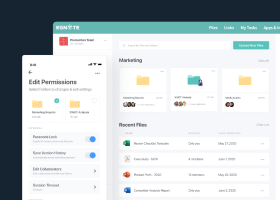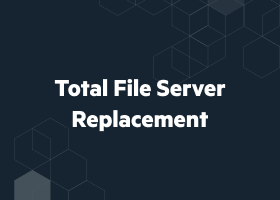File Server Monitoring Tool
File server management software is a tool that allows users to interact with information that is stored central location. With file server management software, users can easily store and share files over a network, allowing multiple users to access files. It facilitates the upkeep of hardware and software components to assure the health of any objects stored in the file server, such as executables, documents, photos, and videos. With file server management software, users can indirectly engage with centrally stored files by accessing them through applications (e.g., QuickBooks, AutoCAD, Microsoft Office).

Transform Your File Server Infrastructure with a Single Platform
Traditional file server infrastructure can be significantly enhanced by consolidating it with a cloud-based file server management software solution. Several reasons to consider this approach are as follows.
Reduce NAS Footprint
Move the bulk of data from NAS file servers to the cloud and use file server management software to centralize management and eliminate capacity planning.
Revamp Backup Systems
Improve backup systems and gain instant file recovery by using file server management software to simplify and automate file backup.
Enable Comprehensive File Sharing
File server management software optimizes workforce productivity by providing users with access to files anywhere, from any connected device.
Other Reasons to Use File Server Management Software
Additional benefits of deploying file server management software across an organization include:
- AI functionality available
- Cloud transformation
- Improved user collaboration across remote locations
- Multi-cloud capabilities
- Significant cost reduction compared to traditional file infrastructure
How to Manage a File Server
File server management software helps organizations not only ensure access to users, but also enforce policies and procedures that protect the information that is stored. Following are several best practices that file server management software supports.
User Set Up
Define who the users are, which files and folders they can access, and access permissions.
Version and Retention Policies
Establish and enforce version and file retention policies.
Permissions Policies
Determine the degree to which an individual user or group (e.g., department) can access and alter the state of a file folder or any individually existing object in a file server.
File Grouping Policies
Create and enforce grouping policies that give users the file access they need while sequestering sensitive files regardless of which group, they originate.
Regular Backups
Maintain static, historical records of the state of files on a server (i.e., snapshots) based on a regular backup strategy.
File Recovery
Support advanced recovery methods that include scaling and maintaining file health.
Filer Server Audits
Implement an iterative health audit plan and be able to respond quickly to third-party audits.
What Is a File Monitoring System?
A file monitoring system provides a view into the files' characteristics, such as file age, file count, file size, and title. Additional functionality provided with a file monitoring system includes the following.
- Determine the last modification made to a file
- Inspect files to see if and when they were modified, how they were modified, and who made the changes
- Monitor and detect modifications made to specified files
- Perform an MD5 checksum comparison on files to confirm their integrity
- Restored altered to their original format, if unauthorized edits were made
- Send an alert if the number of files in a directory crosses a predefined threshold
What Are the Different Types of File Servers?
File servers are divided into two main categories—dedicated file servers and non-dedicated file servers. Both can be used more efficiently with file server management software.
Dedicated File Server
Dedicated servers are designed exclusively to provide file server functions for other computers. Although these have separate workstations to support adjacent functions, such as reading or writing files as well as for databases, dedicated file servers are considered highly secure.
Non-Dedicated File Server
Non-dedicated servers are designed for use in multiple capacities, such as file servers and database servers. These file servers can be used simultaneously as a workstation. Non-dedicated file servers are considered to be less secure and are not recommended for sensitive information.
Other Types of File Servers
- X
Special scrub an edit server—can accept data strings in any valid data entry or file format, convert it to any format, validate the existence of the master record, and optionally pass the master record or the scrubbed data back to the calling program - XF
Input/output server—performs various functions, such as READ, CHAIN, and SETLL to a file - XS
Input only or caching server—used in simple CHAIN operations only for input
How to Audit a File Server
File server management software helps organizations audit their file servers to see who, what, where, and when files and folders are created, accessed, modified, copied, or deleted. Using file server management software, organizations can also track and compare permissions across their data. Auditing file server management software also helps identify any malicious activity (e.g., cybercriminals, insider threats), meet the reporting requirements associated with regulatory compliance mandates, and ensure that policies and procedures are adhered to by users.
Among the functions of a file server management software audit are the following.
- Alerting and Reporting
- Analyze data to identify the most active users, most accessed files, and the processes used to access files
- Create reports for security and compliance requirements
- Detect and stop ransomware attacks
- Discover and classify sensitive data
- Flag file extension changes, renaming, deletions, permission changes, and file activities made during non-business hours
- Get information about successful and failed read attempts
- Identify over-privileged users and at-risk data
- Investigate any sudden changes in access trends
- Maintain a record of file copy and paste activities
- Monitor file integrity
- Monitor, alert, and report file accesses and modifications
- Provide a big-picture view of file and folder usage
- Provide alerts when policies are violated, or suspicious activity is detected
- See when users are copying files
- Track changes to files and folders at a granular level
Why Use File Server Management Software
The primary reason to use file server management software is to support the access and modification of files by groups of users. File server management software facilitates the storage and distribution of files, providing a central location to access a single accurate version of any file that is stored in the system.
File server management software essentially provides an abstraction of digital assets from workstations and other devices used by individuals. The quality and efficacy of data stored with file server management software rely on users and managers to follow best practices. These include regular backups, frequent health audits, and the enforcement of strict permissions policies. Used properly, file server management software provides significant benefits to any organization.
Egnyte has experts ready to answer your questions. For more than a decade, Egnyte has helped more than 16,000 customers with millions of customers worldwide.
Last Updated: 5th April, 2023



